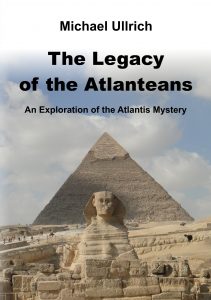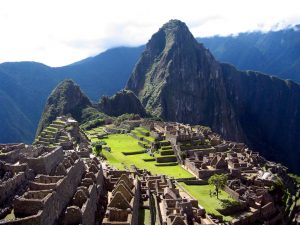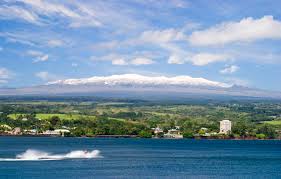“The Legacy of the Atlanteans”
is now available in English language – without pictures – as E-Book and Paperback by Amazon, Google & Co, iBooks, Barnes & Noble, Tolino, txtr. and your local book stores (ISBN 9783741864902). I am sure; you want to know all facts about the ancient culture.
You will find surprising facts about the largely unknown advanced culture existing during the last Ice Age! In my interdisciplinary exploration of the Atlantis mystery, I describe the buildings, technical know-how, and incredible knowledge left by the Atlanteans on several continents before their homeland sank beneath the Atlantic.
The sinking of this enormous island sparked an inferno that annihilated 100 million people worldwide and eradicated 70 animal species in the Americas! How is it then that no one has considered the connection with the famous Calendar Stone, also known as the Sun Stone, which describes catastrophes that occurred 20,000 years ago? Why do scientists still attribute the creation of world-renowned megalithic structures to primitive native tribes with no capacity to hew hard stone with such astounding precision?
I am repeatedly astonished by the discrepancy between the expert knowledge and the scholarly historical writings of those engaged with the extraordinary ancient sites of the Americas. There are more pyramids in Central and South America than in Egypt, not to mention impressive Atlantean structures, made in part of polygonally hewn megaliths whose seams are fitted with unimaginable precision.
The native peoples revered the Atlanteans as “white gods” because of their knowledge, and they awaited their return with longing, all the way up until the arrival of Columbus! One reason for this native reverence of their “gods” may lie in an unusual feature that bears further investigation.
Initial mitochondrial DNA analyses of longitudinally deformed cranial bones from Paracas, Peru, indicate that some Atlanteans may have descended from a species previously unknown among humans, primates, or animals and that this species possessed as much as 25 percent more brain mass than Homo sapiens! Evidence of similar skulls has also been found on other continents, thousands of miles from Peru. When will the experts finally acknowledge that an advanced civilization left its traces not only in Egypt and the Americas but on other continents as well?
You should read some of my statements in my new E-book or Paperback
„The Legacy of the Atlanteans“
in order to get a feeling of its Contents.
1. Atlantis
… The native lore of the Americas relates that 64 million people died on the tragic night when Atlantis sank beneath the sea, triggering momentous natural disasters worldwide! Following the collapse of the island of Atlantis 3000 meters to the bottom of the sea, the Gulf Stream once again flowed about 20 latitudinal degrees to the north, gradually warming the frozen landmass of northern Europe.
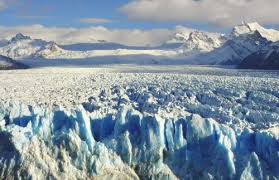 The thousand years that followed saw the melting of the up to two-kilometer-thick mass of ice that covered the northern hemisphere before that time. According to climatologists, the consequence was that the world’s oceans rose by an incredible 120 meters. …
The thousand years that followed saw the melting of the up to two-kilometer-thick mass of ice that covered the northern hemisphere before that time. According to climatologists, the consequence was that the world’s oceans rose by an incredible 120 meters. …
… Below I cite several paraphrased passages from Plato’s dialogues so that the reader can learn of the early recorded details on the advanced Atlantean civilization. At the height of their prosperity, the rulers of Atlantis divided the world among themselves:
“… As related in the previous passage on the drawing of lots between the gods, they divided the whole earth among themselves, partly in large and partly in small portions, ….”
Through their shrewd decisions, the powerful leaders of the Atlanteans were able to develop their colonies, which were spread throughout the world. …
2. The Underground City Beneath the Giza Plateau
… Some Egyptologists and amateur researchers are in doubt as to whether we know all the secrets of the Giza Plateau. In the first half of the previous century, the American “Nostradamus,” Edgar Cayce, prophesied the existence of an underground hall in the vicinity of the Sphinx—a hall that contained the legacy of the Atlanteans! Since then, rumors have persisted that a “Hall of Records” with important transmissions was located there.
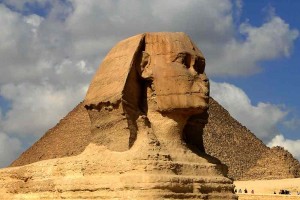 Using specialized equipment, co-workers from Japan’s Waseda University investigated the enormous statue and its immediate surroundings. In the process, they discovered underground caverns and tunnels. One underground passage allegedly leads to a small chamber that lies beneath the lion’s paws. From there, a passageway slopes downward at a steep angle to a second lower, larger chamber that is said to be empty. From this chamber, three passageways branch off that could lead either to the Giza Plateau, the Hall of Records, or a deeper-lying underground city, hidden until now. …
Using specialized equipment, co-workers from Japan’s Waseda University investigated the enormous statue and its immediate surroundings. In the process, they discovered underground caverns and tunnels. One underground passage allegedly leads to a small chamber that lies beneath the lion’s paws. From there, a passageway slopes downward at a steep angle to a second lower, larger chamber that is said to be empty. From this chamber, three passageways branch off that could lead either to the Giza Plateau, the Hall of Records, or a deeper-lying underground city, hidden until now. …
… Is the Egyptian government aware of the “Halls of Amenti” and the over 12,000-year-old underground city of the Atlanteans? Is that why, at the beginning of the millennium, it erected an expensive, up to 3½-meter-high, electronically secured wall with wire fencing around the Giza Plateau? Is this wall’s sole purpose, according to official statements, to guard the historic treasures from terrorists, tomb raiders, and tourists? No government decides without cause on such lavish measures, which drew vehement protests from the affected populace. Is the official intention of this action to prevent curious scientists from making unauthorized explorations of the underground city?
Within the sand inside the fenced-in area are inconspicuous, partly built-over entranceways that presumably lead to the underground living complex described by Thoth. So far, no archaeologist has been permitted to explore the up to 90-meter, vertically descending shafts. …
… The former Egyptian Minister of Antiquities Dr. Zahi Hawass, who was also in charge of excavations at Giza and other sites, announced in 1997 that Dr. James. J. Hurtak had discovered an underground system of passageways next to the ascent to the Pyramid of Khafre. Those interested can find cross-section diagrams of the 30-meter-deep complex by using the Internet search term “Osiris shaft.”
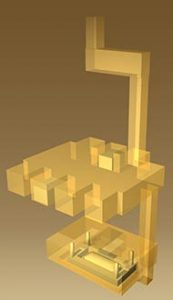 From the narrow, vertical entrance shaft, you can see four meters down to the first level below. At the rear of the empty rock chamber is the next shaft, which leads about 20 meters down to the second level. Six empty sepulchral niches were found in that room. Off to the side, another shaft, which first needs to be pumped dry, leads down to the depths.
From the narrow, vertical entrance shaft, you can see four meters down to the first level below. At the rear of the empty rock chamber is the next shaft, which leads about 20 meters down to the second level. Six empty sepulchral niches were found in that room. Off to the side, another shaft, which first needs to be pumped dry, leads down to the depths.
On one rock surrounded by four columns stands an impressive sarcophagus made of diorite. It is presumed that the rock was continuously encompassed by water, even when the Nile was still lower. Did the water, which once surrounded the Sphinx and the rock with the stone sarcophagus, symbolize the ocean around the island of Atlantis, the original homeland of the Egyptian “gods in human form”? …
3. Bauval’s Insightful Discovery
… The location of the five large pyramids doubtless proves that there was an master plan from the “first time,” when the Atlanteans performed a brilliant cartographic feat in plotting the precise positions of the three pyramids they  intended to build.
intended to build.
The position of the three pyramids on the Giza Plateau necessarily arose through the already begun pyramid over Isis’ burial chamber and the location of the graves of Osiris and Horus. Together, they correspond to the position of the three stars in Orion’s belt circa 10,400 B.C.
The middle pyramid dedicated to Isis was finished by Khafre, while Pharaoh Menkaure built the smallest, off-center pyramid over the tomb of Horus! What fascinates me is that, thanks to the prudence of the Atlanteans, astronomers millennia later can ascertain the time of burial of the “gods in human form.”
These many congruencies between buildings and constellations are no coincidence. In my opinion, the Atlanteans planned the Giza Plateau as a “sacred complex,” where they would live and where their praiseworthy leaders would be buried. …
4. Other Buildings Also Incorporate Dates!
 … In 1996, New Zealander John Grigsby realized that both the number and form of the temple ruins scattered far and wide across Cambodia resembled the dragon constellation, or Draco. Grigsby did not believe this to be a coincidence. With the aid of the software Skyglobe 3.6, he discovered that in circa 10,500 B.C., the position of Draco’s stars was congruent with the temple ruins.
… In 1996, New Zealander John Grigsby realized that both the number and form of the temple ruins scattered far and wide across Cambodia resembled the dragon constellation, or Draco. Grigsby did not believe this to be a coincidence. With the aid of the software Skyglobe 3.6, he discovered that in circa 10,500 B.C., the position of Draco’s stars was congruent with the temple ruins.
How did the Khmer kings know the exact heavenly positions during the “first time,” the time during which the advanced Atlantean civilization came to an end? Did they build the temples on top of ancient foundations? The position of the three Cambodian Roluos temples favors this theory….
5.The Mysterious Pyramids of Bosnia
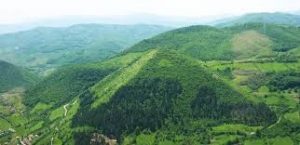 … Is it a coincidence that the tops of the three pyramids are located exactly 2.4 kilometers apart and form a perfect, isosceles triangle? At 220 meters, the Pyramid of the Sun is considerably taller than the Great Pyramid of Khufu on the Giza Plateau!
… Is it a coincidence that the tops of the three pyramids are located exactly 2.4 kilometers apart and form a perfect, isosceles triangle? At 220 meters, the Pyramid of the Sun is considerably taller than the Great Pyramid of Khufu on the Giza Plateau!
Monoliths with ancient hieroglyphs have been found Inside the branching tunnel system. These monoliths appear to have served as signposts. According to some experts, the hieroglyphs resemble characters from the language of an ancient Hungarian civilization from the last ice age! Also found were oval ceramic blocks weighing up to ten tons! Several blocks contained quartz crystals. Was the combination of these rock crystals and the abundant underground streams supposed to release positive energy and heal sickness? …
… There is one phenomenon belonging to the Bosnian pyramids that runs contrary to natural law and that scientists still cannot explain! It is well known that rays emitted from an energy source diminish with increasing distance! Through comprehensive measurements performed by a drone, experts realized that the top of the Sun Pyramid was emitting a broadband ultraviolet ray with a uniform amplitude at a frequency of 0–28.3 kHz, with regular peaks at 9.3333 Hz. It grows stronger rather than weaker with ever greater altitudes. Its width is 4.5 meters, and it has a voltage of 3.9 volts.
Professor Paolo Debertolis and Finnish native Heikki Savol made tape recordings of the vibrations inside the Ravne tunnels and on top of the Pyramid of the Sun. These recordings confirmed the values of the ultrasonic measurements. Inside the tunnels, the tones ranged over two octaves; on top of the pyramid, they were over four octaves! …
6. Settlements and Buildings of the Atlanteans
… In eastern Turkey, on a mountain ridge not far from the town of Sanliurfa, lies the 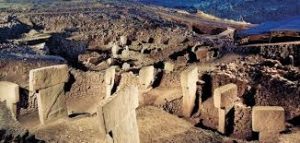 excavation site of Göbekli Tepe, with its unique, monumental temples—probably the oldest in the world! This ritual site was built during the last ice age! Megalithic stone blocks, shaped like an upright T and adorned with reliefs of animals and people, form an oval in whose center are two free-standing, six-foot-tall monoliths weighing about ten tons each. The circular configuration is reminiscent of stone circles in England. Why do these pillars depict plants, animals, and people, the latter without faces? …
excavation site of Göbekli Tepe, with its unique, monumental temples—probably the oldest in the world! This ritual site was built during the last ice age! Megalithic stone blocks, shaped like an upright T and adorned with reliefs of animals and people, form an oval in whose center are two free-standing, six-foot-tall monoliths weighing about ten tons each. The circular configuration is reminiscent of stone circles in England. Why do these pillars depict plants, animals, and people, the latter without faces? …
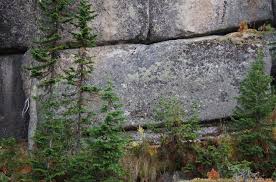 … On the southern Siberian mountain of Gornaya Shoria, megaliths are piled one on top of the other to form a huge wall. People standing next to it look like dwarves. Researchers have found up to ten-meter-tall human skeletons in the most diverse places on earth, but even these “giants” could not have moved these megaliths, which at their heaviest have been estimated to weigh 4000 tons.
… On the southern Siberian mountain of Gornaya Shoria, megaliths are piled one on top of the other to form a huge wall. People standing next to it look like dwarves. Researchers have found up to ten-meter-tall human skeletons in the most diverse places on earth, but even these “giants” could not have moved these megaliths, which at their heaviest have been estimated to weigh 4000 tons.
Did the Atlanteans possess such large machines that they could cut granite like “butter in the sun” and effortlessly polish its surface? In Gornaya Shoria, it would have taken an army of workmen to transport, assemble, and operate such a machine! …
7. Prehistoric Astronomy
… The earliest prehistoric astronomers observed the heavens more than 25,000 years ago. During the last ice age, they already knew how to determine the day, month, and year of the time in which they lived. Over countless generations, they constantly increased their knowledge. The more sophisticated their methods of observation became, the better they could recognize the recurring patterns of different stars or constellations, along with the fact that our earth has a normally imperceptible wobble.
In my opinion, these astronomers belonged to the advanced Atlantean civilization, which divided the stars into 12 equal periods of 30 degrees and assigned astrological symbols to them. From this perspective, it is clear why the Sphinx—the world’s most monumental statue, which embodies the astrological sign of Leo—is aligned on an east-west axis. Only in this way could the Atlanteans indicate the date of the monument’s creation for future generations. …
… Astronomers have discovered that the impressive complex at Teotihuacán, Mexico, mirrors our solar system. If we start from the premise that the Quetzalcoatl Temple reflects the position of the sun, then the remaining buildings correspond to 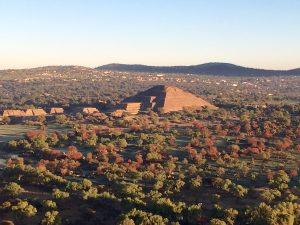 the planets of our solar system according to their size and distance. Furthermore, the labor needed to build Teotihuacán was equal to that required for the construction of the seven largest Egyptian pyramids. Can we seriously believe that the indigenous American peoples from thousands of years ago, with their primitive living conditions, would have known the distances between the planets of our solar system? And could they have made the massive effort required to transmit their knowledge to succeeding generations through these monuments? As usual, archaeologists are puzzled over which people built the city with these famous Central American pyramids. …
the planets of our solar system according to their size and distance. Furthermore, the labor needed to build Teotihuacán was equal to that required for the construction of the seven largest Egyptian pyramids. Can we seriously believe that the indigenous American peoples from thousands of years ago, with their primitive living conditions, would have known the distances between the planets of our solar system? And could they have made the massive effort required to transmit their knowledge to succeeding generations through these monuments? As usual, archaeologists are puzzled over which people built the city with these famous Central American pyramids. …
8. The Coincidences Are No Accident!
… For the first time, a mysterious burial chamber was discovered in a pyramid in the Americas. In 1949, Mexican archaeologist Alberto Ruz Lhuillier noticed the precisely hewn floor slats in the Temple of the Inscriptions, some with circular indentations. On lifting them up, he stumbled upon a rubble-filled hollow, which proved to be a stairway that took until 1952 to clear.
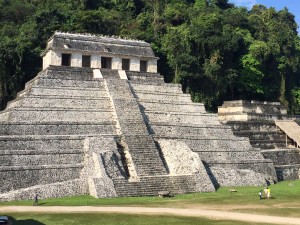 The steep set of stairs led down to a corbel-arched antechamber that was found to contain the skeletons of young sacrificial victims or servants as well as stone chests with colored bowls, jade earplugs, pearls, and ceramic bowls. Behind the triangular stone slab, Lhuillier discovered a ten-by-four-meter corbel-arched room that lay 25 meters beneath the temple and was exactly positioned on the central axis of the pyramid.
The steep set of stairs led down to a corbel-arched antechamber that was found to contain the skeletons of young sacrificial victims or servants as well as stone chests with colored bowls, jade earplugs, pearls, and ceramic bowls. Behind the triangular stone slab, Lhuillier discovered a ten-by-four-meter corbel-arched room that lay 25 meters beneath the temple and was exactly positioned on the central axis of the pyramid.
Is it yet another coincidence that the corbel arch, a form that only rarely occurs in the Americas, was likewise used in the burial chambers of megalithic cultures as well as in the Egyptian pyramids? …
… The most famous scene in Mayan art, a carving on the lid of the sarcophagus, 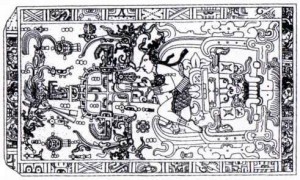 has sparked heated discussions among researchers. In its center, we see a figure crouched on top of a demon head. The figure is in a fetal position and apparently portrays Pakal in the underworld. Growing from his body is a tree adorned with many symbols, and upon the tree sits a supernatural bird that is devouring something. A two-headed snake divides the image, its winding body forming the shape of a bell.
has sparked heated discussions among researchers. In its center, we see a figure crouched on top of a demon head. The figure is in a fetal position and apparently portrays Pakal in the underworld. Growing from his body is a tree adorned with many symbols, and upon the tree sits a supernatural bird that is devouring something. A two-headed snake divides the image, its winding body forming the shape of a bell.
Are we perhaps dealing here with a depiction of the “white god Quetzalcoatl”? Was the Atlantean leader in charge of Central America interred at Palenque? According to the myths of the native peoples, Quetzalcoatl united within himself two creatures unlike each other in type and essence: the Quetzal bird, which ruled the air; and the rattlesnake, which crept upon the ground. Did the tropical bird symbolize the ability of some Atlanteans to raise themselves into the air and fly like a bird? Some arguments support this! The Egyptians were also familiar with the symbol of the feathered snake. To them, this concept signified a master teacher of astronomy and architecture, an idea that could apply to Quetzalcoatl. Feathered snakes can also be admired at the temple in the sacred complex of Angkor Wat. Are all the coincidences mentioned so far an accident? That is highly unlikely. …
9. Stone Heads, Reliefs, and Stone Spheres
… Returning to the approximately two-meter-high head unearthed at “Tres Zapotes,”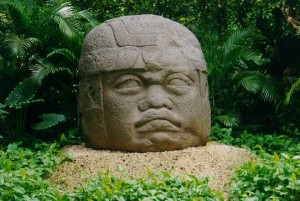 we note that it is crowned by a tight-fitting helmet with a long chin strap. The facial features resemble those of an African with his ears pierced by posts, as is sometimes still seen there. The work of the stonemason is complete, meaning that the proportions of the head are balanced. With its thick lips, strong brow, and the cold stare of its almond-shaped eyes, the statue appears extremely realistic.
we note that it is crowned by a tight-fitting helmet with a long chin strap. The facial features resemble those of an African with his ears pierced by posts, as is sometimes still seen there. The work of the stonemason is complete, meaning that the proportions of the head are balanced. With its thick lips, strong brow, and the cold stare of its almond-shaped eyes, the statue appears extremely realistic.
None of the 16 stone heads found in the Olmec region have torsos. The largest head weighs over 30 tons. The stone heads discovered there match the monumental style of the Atlanteans, and the impeccable workmanship betrays the use of their “high-tech” tools!
Archaeologists believe that the Olmec settled along the coast of Central America before the birth of Christ. So far, no has explained the origin of these people, whose colossal heads are universally known. Were they Atlanteans? And was their practice of sculpting enormous heads so unusual? We, too, honor our deserving individuals of bygone centuries by erecting busts or statues in public places. …
In Tula in northern Mexico, the Toltecs erected giant stone figures with mysterious, uni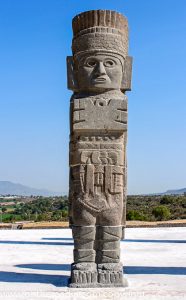 form faces. Instead of the usual columns in Europe or Egypt, these outsized figures, which they called “Atlanteans,” supported a temple on their heads. Did the one-time pyramid-shaped roof of the temple symbolize the knowledge of the white gods? Or was it a shadow of their island home?
form faces. Instead of the usual columns in Europe or Egypt, these outsized figures, which they called “Atlanteans,” supported a temple on their heads. Did the one-time pyramid-shaped roof of the temple symbolize the knowledge of the white gods? Or was it a shadow of their island home?
I am convinced that the names Atlán, Aztlán, Atitlán, Atlantean, Atlantis, Atlantic, and Atlas, the last of whom carried the world on his shoulders, are intimately related! This profusion of similar terms is no coincidence! …
10. Unfamiliar “High-Tech” Tools
… All across the world, researchers are puzzled as to how people 12,000 years ago could process even the hardest stone with such precision. Why do scientists ignore the clues in the most diverse peoples’ myths about their “gods,“ revered because of their extraordinary capabilities? And how is it that experts still attribute the impressive structures built with megaliths to peoples who lived in primitive conditions, even when the latter possessed neither suitable hand tools for precise processing nor the transportation with which to move the stone blocks, which often weighed several hundred tons?
Scientists seldom dare to construct theories that contradict the general scientific way of thought! Instead, they prefer to place their faith in the dating of organic remains from a previous era, often thousands of years earlier. There is still no recognized method with which experts can reliably determine the period when the stones were processed. …
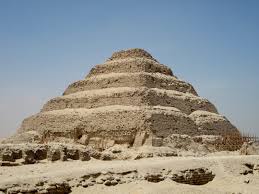 … Beneath the Djoser Pyramid in Saqqara, archaeologists discovered a large labyrinthine complex consisting of 400 chambers, magazines, passages, and stairways. After reading Thoth’s Emerald Tablet, I wondered whether the Atlanteans had lived there.
… Beneath the Djoser Pyramid in Saqqara, archaeologists discovered a large labyrinthine complex consisting of 400 chambers, magazines, passages, and stairways. After reading Thoth’s Emerald Tablet, I wondered whether the Atlanteans had lived there.
The magazines contained 30,000 vessels, some of which had been hewn with “high-tech” tools. Bulbous stone vases, with sides of even thickness and long, narrow necks, show no traces of the workmanship involved. Urns with delicate ornamental handles, bowls, tiny bottles, and objects with wheel-like contours all betray the craftsmanly capabilities of an unknown advanced civilization admired by experts.
Were these the everyday implements of the Egyptian “gods in human form”? Favoring this theory is the fact that most of the vessels match other finds from predynastic geological layers! My guess is that countless artifacts from the advanced Atlantean civilization lie slumbering in our museums and that our ignorance has led us to attribute them to later peoples. …
… It matters little whether we are dealing with giant sun gates, statues, megaliths, or rectangularly or polygonally hewn granite blocks. The experts are invariably puzzled as to which people 12,000 years ago was capable of processing even the hardest stone with such precision. There is, however, one point on which they all 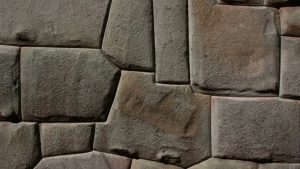 agree: these masterpieces of workmanship did not stem from the indigenous peoples of that period! Only very seldom do scientists dare to mention the unparalleled advanced civilization of Atlantis, even though its remnants cannot be overlooked and there is no other alternative. Why do the experts not acknowledge the connections despite ample clues in all fields?
agree: these masterpieces of workmanship did not stem from the indigenous peoples of that period! Only very seldom do scientists dare to mention the unparalleled advanced civilization of Atlantis, even though its remnants cannot be overlooked and there is no other alternative. Why do the experts not acknowledge the connections despite ample clues in all fields?
The buildings at Tiahuanaco, Puma Punku, Sacsayhuaman, Cuzco, and Machu Picchu as well as the artifacts from the Nazca Plateau all furnish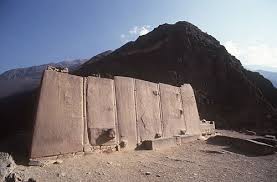 impressive proof of the presence of the Atlanteans. In South America, the stones they blasted out of the rock were larger and harder than those in Egypt; and in regions with abundant volcanoes, they protected their buildings from earthquake damage by employing polygonal forms in their processing of the megaliths.
impressive proof of the presence of the Atlanteans. In South America, the stones they blasted out of the rock were larger and harder than those in Egypt; and in regions with abundant volcanoes, they protected their buildings from earthquake damage by employing polygonal forms in their processing of the megaliths.
11. The Origin of Metalworking
I turned to the National Tourism Organisation of Malta and received some extremely revealing information:
“… The only pair of cart ruts that we know of [that] go down below the water are situated at Saint George´s Bay [in] Birzebbugia. These used to reappear at the other side of the bay some hundred metres away before the present street was built up.
“… It is therefore thought that the cart ruts were dug when the sea level was much lower so that the cart ruts could be followed and the silo pits could also be filled with material without … being reached by the waters. The silo pits today are partly submerged by the sea ….”
From this, we can l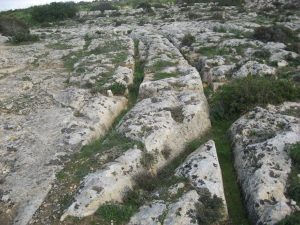 ogically deduce that the tracks date from a period when the sea level was lower. Were these remnants actually so old? I was amazed. The cart ruts leading into the sea and the silo that was half covered by it were indeed created by a people from 10,000 B.C., for as the geologists assured me, the island had not sunk since then!
ogically deduce that the tracks date from a period when the sea level was lower. Were these remnants actually so old? I was amazed. The cart ruts leading into the sea and the silo that was half covered by it were indeed created by a people from 10,000 B.C., for as the geologists assured me, the island had not sunk since then!
In my view, the Atlanteans had large-sized natives lay the wide tracks in Meca and Tiermes. They transported and smelted extremely valuable minerals that Uwe Topper describes as follows:
“… The ore was probably embedded in the limestone in lump form. The deposits, still plentiful in prehistoric times, were almost entirely mined away. These ore deposits can be traced back to meteorite swarms that collided with the earth over millions of years ….”
Iron ore is extraordinarily rich in nickel, behaves like steel, and does not rust. The “high-tech” tools made of meteorite ore were equipped with diamond-studded heads. When the tools wore out, they were presumably melted down and made into new chisels, saws, and drills. …
12. Mysterious Crystal Skulls
 In 1924, Anna Mitchell-Hedges discovered the most famous crystal skull, weighing 5.30 kilograms, in a temple complex in the Honduran jungle. The eye sockets, zygomatic arches, and mastoid processes matched the actual anatomy of a human skull. In contrast to later finds, the lower jaw was movable. There is also talk that Mitchell-Hedges purchased the crystal skull from Sidney Burney, the previous owner, for £400 at a 1943 Sotheby’s auction.
In 1924, Anna Mitchell-Hedges discovered the most famous crystal skull, weighing 5.30 kilograms, in a temple complex in the Honduran jungle. The eye sockets, zygomatic arches, and mastoid processes matched the actual anatomy of a human skull. In contrast to later finds, the lower jaw was movable. There is also talk that Mitchell-Hedges purchased the crystal skull from Sidney Burney, the previous owner, for £400 at a 1943 Sotheby’s auction.
Art restorer Frank Dorland studied the skull for years, while the research division of the electronics enterprise Hewlett Packard investigated it for only a brief time. The unanimous conclusion was that the skull and lower jaw were made from a single piece of crystal.
No traces of mechanical processing were found, and the evaluation was that the natives, with their primitive means, would have had to uninterruptedly grind the quartz for about 300 years in order to fashion it in an equivalent manner. We can eliminate this option, in my opinion, since no people would take generations to process crystal that was of absolutely no use to them. …
… Numerous questions arise even upon critical consideration of the origin of the crystal skulls. Were they used for ritual purposes? Was the enormous expenditure of effort worth it? Did the Atlanteans use polished crystal lenses in their telescopes? Are the sound waves above the Bosnian Sun and Moon Pyramids amplified through the use of rock crystal? I hope that the experts will find answers to my unsolved questions. Perhaps then we will learn the meaning and purpose of these few mysterious crystal skulls that the Atlanteans evidently polished against their natural axes. …
13. Easter Island
In 1722, the Dutch captain Jacob Roggeveen discovered Easter Island, which was home to two different races. The majority of the population was stocky, with black hair and brown skin; the minority was tall and redheaded with light skin! I find this entry in his logbook sensational!
Were the tall, light-skinned people with red hair the descendants of the advanced Atlantean civilization? Why did archaeologists also find mummies with red hair in the Peruvian Andes, along the western coastline of South America, and in Brazil? Where did their ancestors come from?
The indios have pitch black hair that is by no means red. Researchers who deal with the ancestral make-up of the Americas assure us that they descended from the original immigrants who crossed the Bering Strait from Siberia. From which area did the white-skinned inhabitants with reddish hair originate? This question will engage the attention of our scientists for a long time to come! …
What remain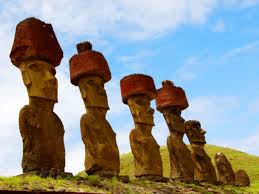 s unexplained is the actual time frame required by the Easter Island populace to hew 1000 extremely different stone statues, the largest measuring 21 meters and weighing 360 tons, and then erect them in suitable locations. With the exception of two coastal areas with an abundance of volcanoes, the monuments, with their outsized appearance, look out from every direction over the sea or island. Were they, like the indigenous Americans themselves, longingly awaiting the return of their white gods? Given the lack of informative traditions, no one knows why the inhabitants created so many moai that look so different.
s unexplained is the actual time frame required by the Easter Island populace to hew 1000 extremely different stone statues, the largest measuring 21 meters and weighing 360 tons, and then erect them in suitable locations. With the exception of two coastal areas with an abundance of volcanoes, the monuments, with their outsized appearance, look out from every direction over the sea or island. Were they, like the indigenous Americans themselves, longingly awaiting the return of their white gods? Given the lack of informative traditions, no one knows why the inhabitants created so many moai that look so different.
Archaeologists wanted to excavate underneath some 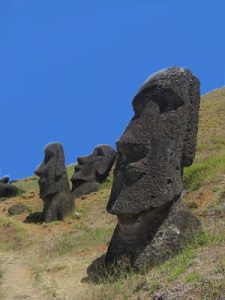 of the elongated heads. They had to dig six meters before determining to their surprise that the heads possessed bodies covered with petroglyphs! Did the natives bury the figures, or did a correspondingly thick layer of earth build up over the course of the last 12,000 years? Did the figures with their elongated heads stem from the advanced Atlantean civilization?
of the elongated heads. They had to dig six meters before determining to their surprise that the heads possessed bodies covered with petroglyphs! Did the natives bury the figures, or did a correspondingly thick layer of earth build up over the course of the last 12,000 years? Did the figures with their elongated heads stem from the advanced Atlantean civilization?
14. Andean Artefacts of the “White Gods”
… More pyramids have been found in the Americas than in Egypt! With some exceptions, they have steep steps on all four sides, often with encircling terraces and a simple temple or observatory on the upper platform.
On the Pacific coast of South America, the indigenous peoples mostly constructed their pyramids with adobe bricks, which over time disintegrated to form large earthen mounds that to a layman would no longer be recognizable as a building. The Mesopotamian pyramids made of adobe bricks show the same signs of deterioration. There they are called “ziggurats.”
The Central American pyramids are composed primarily of stone, with their interiors  often made of earth or macadam. In North America, the natives built earthen hills, or mounds. Similar monuments are viewable in France and England. “What an amazing coincidence!” the astonished reader may think.
often made of earth or macadam. In North America, the natives built earthen hills, or mounds. Similar monuments are viewable in France and England. “What an amazing coincidence!” the astonished reader may think.
Explorers worldwide have discovered only a few pyramids with smooth surfaces or structures made of megaliths. In my view, these are the hallmarks of the Atlantean construction style. Is it any wonder that the Atlanteans, who were natives of mountainous regions, settled in the Andes because of the similar living environment?
Lake Titicaca, which surprisingly features both salt water and marine fauna, is situated at an altitude of 3000 meters. Over the course of the millennia, its water volume decreased, but in spite of that, it is the largest and highest-lying navigable lake in the world. The town of Tiahuanaco, once situated on an island, today lies 20 kilometers inland from the lakeshore.
The architects of Tiahuanaco employed unusually large monoliths that were seldom used in construction in South America. With a length of up to nine meters, a width of five meters, and a height of two meters, these monoliths were slightly narrower than those found in the Baalbek quarry! …
… Within the strict geometrical layout of Tiahuanaco’s Kalasasaya enclosure stands what is possibly South America’s most famous structure, the Gateway 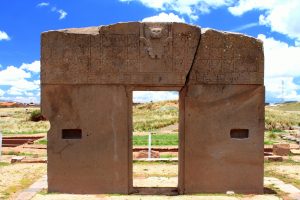 of the Sun. On the equinoxes, the sun rises in the center of the gate. The giant stone gateway, hewn from a single large rock, weighs seven tons. It features a frieze, still undeciphered today, that shows depictions of an elephant head, a South American mastodon, and a toxodonton, a creature that resembles a hippopotamus. These animals went extinct in the Americas between 12,000 and 10,000 B.C.!
of the Sun. On the equinoxes, the sun rises in the center of the gate. The giant stone gateway, hewn from a single large rock, weighs seven tons. It features a frieze, still undeciphered today, that shows depictions of an elephant head, a South American mastodon, and a toxodonton, a creature that resembles a hippopotamus. These animals went extinct in the Americas between 12,000 and 10,000 B.C.!
On the back side of the Gateway of the Sun are numerous perpendicular borders as well as indentations and drilled holes. None of the experts believe that simple indios could have done such a masterful job processing the hardest of rocks, such as diorite. Even we, with our CNC-controlled machines and diamond-studded tools, would not be able to produce the equivalent of the giant stone gate with such precision. …
… In 1911, high up in the mountains, American archaeologist Hiram Bingham III discovered a city shrouded in mystery. With a spread of five square kilometers, Machu Picchu provided 1000 Inca with protection from pursuers. Excavation revealed homes, shrines, temples, aqueducts, baths, and the residences of the royal family and their servants.
The ruins also feature large stone blocks weighing up to 200 tons. The foundation walls are superbly preserved, affording an overall impression of the complex, with its breathtaking view of the mountaintops of the Peruvian Andes, which daily inspire awe in hundreds of tourists. Local guides inform visitors that stones carved in the mountainsides surrounding the city were done in a way that depicts the silhouettes of human faces and bodies.
Experts cannot agree on the age of Machu Picchu. Most believe that the builder of the city was the abovementioned mighty Pachacuti, who had the high-lying town built as a country seat. Like the Maya, the Inca also obliterated any traces of the true origin of the Atlantean artifacts. In this way, they could better accentuate their own accomplishments to their people. …
… I maintain that the foundations at Machu Picchu, the citadel area at Sacsayhuaman, and the structures built with polygonally hewn stones at Cuzco, Tiahuanaco, Puma Punku, and other sites all originated with Atlanteans who settled in the Andes during the last ice age! …
15. Enigmatic Miniature Aircraft
 … In the Gold Museum of the Colombian capital of Bogotá, in the city of Bremen, and in other places as well, we can admire small gold airplanes taken from the tombs of South American princes. These miniature aircraft have raised tailfins, small narrow rear wings, and delta wings beneath the fuselage. Although they look like airplanes, the captions at the museum exhibits refer to reproductions of fish, insects, or bird species. No one dares to call these mysterious miniatures “airplanes,” even though larger-scale models, with or without remote control, have demonstrated outstanding flying qualities. The narrow aperture set into the fuselage for the pilot has not interfered.
… In the Gold Museum of the Colombian capital of Bogotá, in the city of Bremen, and in other places as well, we can admire small gold airplanes taken from the tombs of South American princes. These miniature aircraft have raised tailfins, small narrow rear wings, and delta wings beneath the fuselage. Although they look like airplanes, the captions at the museum exhibits refer to reproductions of fish, insects, or bird species. No one dares to call these mysterious miniatures “airplanes,” even though larger-scale models, with or without remote control, have demonstrated outstanding flying qualities. The narrow aperture set into the fuselage for the pilot has not interfered.
Even the ancient Egyptians were familiar with flying machines, as proved by two small wooden models hidden in the archives of the Museum of Egyptian Antiquities until discovered by Dr. Khalil Messiha. Mystified, the experts determined that they were dealing with equilibrated flight models that could fly for long periods with little need for propulsion. As with the Concorde, the wings were aerodynamic and bent slightly downward. The airplanes were designed to carry heavy loads. …
… Anyone who thinks my description of a launching pad for gliders is too bold should consider the following: a nation that possessed “high-tech” tools, sailed the oceans, had detailed knowledge of the workings of our solar system, and transmitted that knowledge in the form of exact data would surely attempt to build flying machines that they could operate with the help of cords. They wanted to soar through the air like the condor. …
… Near Santa Cruz in Bolivia, on the summit of El Fuerte de Samaipata beside the remains of earlier settlements, we can see two parallel grooves that are 38 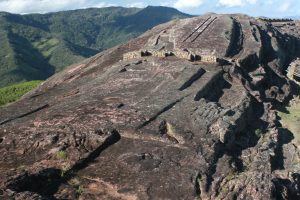 centimeters wide and 27 meters long. Archaeologists have wondered what function these unusually long grooves possessed. Above them, within a hollowed-out area, are circles hewn from rock and featuring geometrical patterns. In the center of this puzzling “artwork” is a hole large enough to contain a stout trunk.
centimeters wide and 27 meters long. Archaeologists have wondered what function these unusually long grooves possessed. Above them, within a hollowed-out area, are circles hewn from rock and featuring geometrical patterns. In the center of this puzzling “artwork” is a hole large enough to contain a stout trunk.
Did the Atlanteans wrap a rubber cord around the trunk and connect it to a glider that could seat a pilot? Did they stretch the rubber cord by turning the log with the aid of horizontally affixed beams? Did they wedge the crossbeams into the geometrical grooves when they needed to gather added power? Or if the rubber cord was extremely tense, did they wait for the safety rope to be cut from the tail of the aircraft in order to catapult it into the air? The geometrical forms are another indication of the advanced Atlantean civilization! …
… With this perspective, we can begin to understand the legend of a native Costa Rican people that a wondrous object was buried at the summit of Chirripò, an object that could fly and that found its way through reflections of light from spheres that were polished smooth. The natives call the path up the mountainside “the way to the graveyard of the golden machine.”
16. The Revealing Nazca Plateau
 … If we accept the opinion of archaeologists, then it was the simple natives who created these figures thousands of years ago to please their gods in the heavens! What a simplistic explanation for such a tremendous effort performed by the Atlanteans! Except for one flower, the thirty-two best-known etched drawings so far all deal with depictions of animals. One fish measures 25 meters; the spider, 46; the monkey, about 60; one condor, 110; and the hummingbird, with its long beak, 250 meters! We constantly encounter the Atlanteans’ proclivity for leaving giant relics to posterity.
… If we accept the opinion of archaeologists, then it was the simple natives who created these figures thousands of years ago to please their gods in the heavens! What a simplistic explanation for such a tremendous effort performed by the Atlanteans! Except for one flower, the thirty-two best-known etched drawings so far all deal with depictions of animals. One fish measures 25 meters; the spider, 46; the monkey, about 60; one condor, 110; and the hummingbird, with its long beak, 250 meters! We constantly encounter the Atlanteans’ proclivity for leaving giant relics to posterity.
Experts are still puzzled over how these artists managed to apply the natural dimensions of the images to the abovementioned sizes, given that they were unable to view the results of their work from the air. If my theory is correct, then the Atlanteans surveyed their works from gold-painted gliders.
For people to be able to fly like birds and to be easily visible by sparkling in the sun made a deep impression on the natives and strengthened their belief that the strangers were gods. In India, the Atlanteans were significantly more creative. There, on the plains of the subcontinent, they tried out a variety of flying machines that I shall also describe later. …
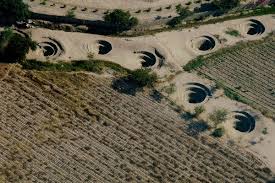 … More than 12,000 years ago, technically gifted Atlanteans dug beneath the desert in crawl passages six meters below the ground, where they laid extremely heavy and cumbersome U-shaped, hollowed-out granite blocks with covers as well as the necessary slant. These blocks had been processed in distant quarries and transported to the plateau.
… More than 12,000 years ago, technically gifted Atlanteans dug beneath the desert in crawl passages six meters below the ground, where they laid extremely heavy and cumbersome U-shaped, hollowed-out granite blocks with covers as well as the necessary slant. These blocks had been processed in distant quarries and transported to the plateau.
The water channels consist of two systems, each 70 centimeters high but with different widths. The enormous effort involved in building them would only make sense if the “water conduits” were located near Atlantean settlements. These were presumably underground cities that afforded their inhabitants protection from the intense heat and from enemies. It would be worth the effort to find them! …
17. DNA of a New Human Race?
… Inside graves found in Patagonia, Bolivia, Peru, Chile, Ecuador, Mexico, and North America as well as in the Eurasian steppe belt, Central and West Africa, Brittany, and ancient Egypt, archaeologists have discovered well-preserved longitudinally deformed skulls!
Medical practitioners have found that when children develop a longitudinal deformation of the head from excessively tight bandages, this often results in the formation of “water on the brain,” rendering them unable to cope! Did people in prehistoric times possess a worldwide knowledge of how to avoid these deleterious consequences?
Why have oblong skulls been found at so many different sites? Were people emulating a role model? Did some citizens of the advanced Atlantean civilization have such a striking profile? The oldest deformed skull belongs to a Neanderthal from around 43,000 B.C.! Does it point to a genetic subspecies of human beings? Or did the longitudinally deformed skulls originate through a genetic mutation like giants and midgets? …
… In fact, there was no hint of the discovery that would become public at the beginning of 2016. Decades prior to that, in the 1920s, archaeologist Julio César Tello Rojas discovered over 300 elongated skulls on the desert peninsula of Paracas in Peru. Among these are the longest skulls ever found. Experts estimate the age of these attractions, on exhibit at a number of museums, as being at least 3000 years old.
Without mentioning the unusual nature of these skulls, the director of the Paracas History Museum took teeth, hair, and bone from the deformed sk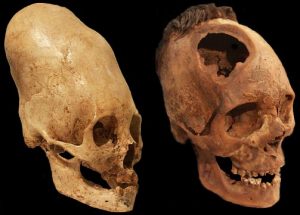 ulls and sent them to a lab for DNA testing. The analyses showed the deceased as being descended from no known human beings, primates, or animal species. The mitochondrial DNA (mDNA) from some of the body parts differed from that of Homo sapiens, Neanderthals, or Denisova hominim, the last of whom lived 40,000 years ago in the Altai Mountains in Southern Siberia. Could this new species of human only mate among themselves? This is one of the fascinating questions that no one can answer until further DNA analyses become available.
ulls and sent them to a lab for DNA testing. The analyses showed the deceased as being descended from no known human beings, primates, or animal species. The mitochondrial DNA (mDNA) from some of the body parts differed from that of Homo sapiens, Neanderthals, or Denisova hominim, the last of whom lived 40,000 years ago in the Altai Mountains in Southern Siberia. Could this new species of human only mate among themselves? This is one of the fascinating questions that no one can answer until further DNA analyses become available.
Worth mentioning is that the subspecies discovered possessed up to 25 percent more brain mass and was probably more intelligent than the rest of mankind. Several of the mummified skulls had red hair, which the native Indians never possessed. Evidence of trepanation in the upper part of the skull indicates that these individuals’ brains were operated on. Was this done by tribal medicine men or surgeons from an advanced civilization? …
18. Underwater Archaeology
… Following the end of the last ice age, all Atlantean harbor cities were submerged by rising ocean levels. More and more, oceanographers are finding remnants from the time of the advanced Atlantean civilization. These remnants are distinguished by their megalithic architectural style, but decades will pass before archaeologists acknowledge the true age of these finds and attribute them to the Atlanteans, who sailed the oceans in 1200 ships and settled countless sites. …
… Using the term “Yonaguni Monument” to search the Internet, we can view a number of photographs and videos of a set of structures whose top lies roughly six meters below the surface of the water and from there extends to a depth of 27 meters. Yonaguni is the southernmost island of Japan, close to Taiwan. The pyramid-shaped Yonaguni Monument lies off the island’s coast to the south. During the last ice age, the base of this underwater pyramid stood at an elevation of 90 meters above the surface of the water. In my opinion, this region was an Atlantean settlement.
There is vigorous debate among experts about whether the monument is a natural phenomenon or a humanly created edifice. After intensive engagement with it, Professor Masaaki Kimura, a geologist at Okinawa University, c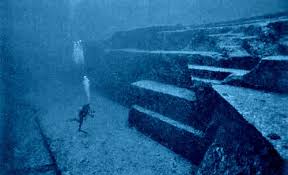 oncluded that it was a man-made structure hewn from a mass of rock. As proof of his theory, the professor cited a rectangularly carved, absolutely straight trench that was precisely aligned on an east-west axis. In his view, evenly spaced steps, right angles, extremely smooth surfaces, two-meter-deep holes, and adjacent monoliths of equal size were all the work of human hands. The web pages on this show massive, sharp-edged, right-angled terraces that match the architectural style of the step pyramids in the Americas. If the sea had shaped these forms, then the angles would be rounded and the stones that fell out would be lying at the foot of the monument. That is not where they were found! …
oncluded that it was a man-made structure hewn from a mass of rock. As proof of his theory, the professor cited a rectangularly carved, absolutely straight trench that was precisely aligned on an east-west axis. In his view, evenly spaced steps, right angles, extremely smooth surfaces, two-meter-deep holes, and adjacent monoliths of equal size were all the work of human hands. The web pages on this show massive, sharp-edged, right-angled terraces that match the architectural style of the step pyramids in the Americas. If the sea had shaped these forms, then the angles would be rounded and the stones that fell out would be lying at the foot of the monument. That is not where they were found! …
… The remains of a street as well as the foundations of buildings and squares have been found on the ocean floor north of Bimini. In 1968, along with three divers, Dr. J. Manson Valentine discovered additional ruins. Off the island of Andros, pilots photographed large circular formations. Meanwhile, we know of a great number of “submerged settlements” in the region of the Bahamas.
The list continues. A sunken city was discovered off Haiti; near Cuba, remnants of buildings have been discovered covering an area of about 40 s quare kilometers! Pauline Zalitzki and Paul Weinzweig investigated this huge “city” with the aid of a diving robot. Confirming earlier reports, they found several sphinxes, four gigantic pyramids, and many building remains.
quare kilometers! Pauline Zalitzki and Paul Weinzweig investigated this huge “city” with the aid of a diving robot. Confirming earlier reports, they found several sphinxes, four gigantic pyramids, and many building remains.
Explorers have further come across ruins near Santo Domingo as well as off the eastern coast of Yucatán. Off Honduras, they have found streets. Near Nicaragua, cyclopean walls of a straight or circular construction remind us of some of the structures already mentioned. There is even a wall extending several kilometers into the sea off the eastern coast of South America.
Archaeologically trained divers have repeatedly confirmed that the ruins found on the ocean floor off the eastern coast of the Americas were man-made. Mangrove roots growing over hewn stones were measured using the carbon-14 method, which dated them from around 12,000 B.C., proving that the ruins were present before the end of the last ice age! …
19. India’s Secrets
… A large number of individual standing monoliths, tombs made of imposing stones, and artifacts processed with “high-tech” tools have been found in India, all of which demonstrates both the Atlantean inclination toward the gigantic and their technical prowess!
Among the unparalleled monuments built by the Atlanteans are the Ellora Caves. No other people before 12,000 B.C. ever blasted 400,000 tons of extremely hard stone from a rocky cliff and hauled away the broken-off stones to build a religious site! The unmistakable Atlantean signature is revealed in a multi-story temple, with smooth walls and rectangular columns with T-beams reminiscent of Göbekli Tepe. Subsequent generations carved typically Indian, overly ornate designs on the outer walls of the remaining temple. But what interested me was why the Atlanteans would take on such an enormous amount of work.
of extremely hard stone from a rocky cliff and hauled away the broken-off stones to build a religious site! The unmistakable Atlantean signature is revealed in a multi-story temple, with smooth walls and rectangular columns with T-beams reminiscent of Göbekli Tepe. Subsequent generations carved typically Indian, overly ornate designs on the outer walls of the remaining temple. But what interested me was why the Atlanteans would take on such an enormous amount of work.
Researchers have been mystified as to why small streams disappear into inaccessible tunnels in the rock and why they fail to re-emerge at any point. Why did the Indian government bolt the entrances to the underground areas thirty years ago, in addition to filling hundreds of small holes in the temple floor with cement and barring the narrow, vertical shafts leading down to the depths? Was it so that the public, as in Egypt, would never learn that an unknown advanced civilization once made its home here? Did the Atlanteans build a subterranean city beneath the Ellora Caves, a place to live and seek protection in case of armed conflict with the natives? Did they obtain fresh drinking water from the inaccessible streams, along with ample fresh air from the narrow vertical shafts and the numerous holes in the temple floor? …
… In the 4000-year-old Sanskrit language, we find descriptions of vimanas, a generic term for “aircraft.” The drawings circulating on the Internet appea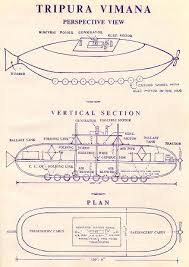 r extremely professional and detailed. Some display modern propellers that must have been either electric or driven by an unknown type of motor.
r extremely professional and detailed. Some display modern propellers that must have been either electric or driven by an unknown type of motor.
In the course of my researches on Atlantis, I had the growing impression that the main sites for investigations into our solar system were located in Central and South America. There, through buildings or geoglyphs, astronomers and mathematicians left a legacy of unusual knowledge for their time.
India, on the other hand, was evidently home to competent engineers who tested a variety of flying machines on the lowland plains. In a comprehensive report, Indian professor Dileep Kumar Kanjilal divided the vimanas, as described in the Sanskrit texts, into four groups. Interested flight experts will find a fascinating comprehensive literature in these ancient scriptures. …
… The first main grouping in Professor Kanjilal’s catalogue are the Rukma aircraft. These were cone-shaped, mostly gold-colored, and the equivalent of the American or Russian space capsules. The second groupi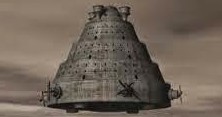 ng, the Sundara, resembled rocketlike, gleaming silver objects with a thunderous take-off. The third, the Tripura, are depicted and described as multistory structures. Perhaps they were filled with gas or hot air, like the zeppelins or hot air balloons. This section also contains illustrations that look like UFOs. Finally, the Shakuna were birdlike flying machines that equate to our airplanes. …
ng, the Sundara, resembled rocketlike, gleaming silver objects with a thunderous take-off. The third, the Tripura, are depicted and described as multistory structures. Perhaps they were filled with gas or hot air, like the zeppelins or hot air balloons. This section also contains illustrations that look like UFOs. Finally, the Shakuna were birdlike flying machines that equate to our airplanes. …
20. The Megalithic Culture
A… The word “megalith” comes from the Greek megas, meaning “large,” and lithos, meaning “stone.” As many as 50,000 structures composed, without exception, of unhewn rocks have been counted worldwide, with a clear focal point in Europe. According to the history books, the megalithic culture spread over the millennia from Europe across India, Korea, and Japan, amazingly all the way to Colombia—and this despite the fact that Columbus had not yet discovered America. The oldest monuments are thought to be from around 5000 B.C., with the megalithic culture reaching its zenith before the building of the Great Pyramid and dying out towards 2000 B.C. The largest unhewn stones are freestanding menhirs, meaning “long stones” in the Celtic language.
… The megalithic structures served mainly as tombs for individu al and multiple burials as well as for occasional ritual purposes. The cave burial sites and tumuli were covered with either earthen mounds (tumuli) or stone mounds (cairns). Each region developed its own very different architectural style, determined by religious custom, family beliefs, or the family’s financial means. …
al and multiple burials as well as for occasional ritual purposes. The cave burial sites and tumuli were covered with either earthen mounds (tumuli) or stone mounds (cairns). Each region developed its own very different architectural style, determined by religious custom, family beliefs, or the family’s financial means. …
… At Carnac, there are roughly 3000 monoliths in the form of undressed, upright stone rows. The three sites originally comprised 10,000 stones. Ménec, the largest site, includes eleven more or less parallel stone rows extending over a distance of 1165 meters. The stone rows were presumably used for astronomical observations, as calendars, and for religious purposes. …
With the ascending terrain, the stones, which gradually increase in size from the east, present a fascinating scene. At each end, the rows are linked by two large oval slabs surrounded by upright stones. At Cojoux, an important megalithic center in Inner Brittany, another site of standing stones appears to be from around 4500 B.C. …
from the east, present a fascinating scene. At each end, the rows are linked by two large oval slabs surrounded by upright stones. At Cojoux, an important megalithic center in Inner Brittany, another site of standing stones appears to be from around 4500 B.C. …
… Alexander Thom, a twentieth-century professor of engineering at Oxford University, measured over 500 megalithic sites of standing stones in England and France. He found that the circumferences of the stones as well as the distances between them were multiples of a basic unit of measurement equaling .83 meters. He termed this unit of measurement the “megalithic yard.” It was often multiplied by 20 or 40.
As already related, the megalithic yard is just a fraction smaller than the Spanish vara or the longe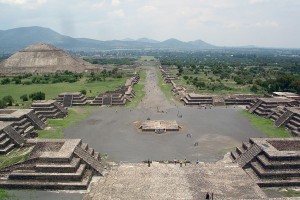 st German ell. I am sure that you can understand my surprise when I realized that these measurements largely corresponded to the Mexican unit of length known as the Teotihuacán Measurement Unit. After years of discussion, scientists have all agreed that the TMU amounts to 0.82 to 0.83 meters!
st German ell. I am sure that you can understand my surprise when I realized that these measurements largely corresponded to the Mexican unit of length known as the Teotihuacán Measurement Unit. After years of discussion, scientists have all agreed that the TMU amounts to 0.82 to 0.83 meters!
How is it possible that a people in Central America’s Teotihuacán—one still unknown to researchers—employed the same unit of measurement that prehistoric peoples in Europe used in their construction of pyramids and buildings for the purpose of depicting our solar system? You know my answer! …
21. Causes and Consequences of the Last Ice Age!
… The frequently above-cited ice age began around 21,000 B.C., at which point the average temperature fell by about 7 degrees. In the northern hemisphere, which was increasingly covered with ice, the temperature hovered at around 9 degrees on average; in the southern half of the globe, at around 4 degrees, according to modern measurements.
These were the results yielded by an experimental model at the Potsdam Institute for Climate Impact Research. The scientists figured that a decrease in solar radiation and a dramatic change in the ocean’s currents precipitated the global cooling. In the Atlantic, the zone where cold water sinks to the bottom and propels the circulation of the oceans shifted just shy of 20 degrees south ward! The result was that instead of moving along Europe’s western coast, the humid, warm air from the Gulf Stream now flowed toward North Africa. As previously described, the region of what today is the Sahara saw the emergence of savannas, lakes, and rivers, all of which benefited the agriculture introduced by the Atlanteans in around 13,000 B.C.
ward! The result was that instead of moving along Europe’s western coast, the humid, warm air from the Gulf Stream now flowed toward North Africa. As previously described, the region of what today is the Sahara saw the emergence of savannas, lakes, and rivers, all of which benefited the agriculture introduced by the Atlanteans in around 13,000 B.C.
At the outset of this book, I describe the climatic developments in Africa and the natural disasters that resulted in decreased agricultural yields, as presumed by Professor Michael Hoffman as well as Wendorf and Schild. Did Egypt experience an disastrous event at the end of the last ice age—an event with grave effects on the life and agriculture of the natives? …
… For a long time, I questioned how the Gulf Stream was pushed 20 latitudinal degrees to the south around 21,000 B.C. And why did it resume its old course more than 12,000 years ago? What obstacle in the Atlantic was placed in the way of the roughly 800-kilometer-wide Gulf Stream?
I have found only one plausible explanation for these important questions! According to Plato’s account, the north-south stretch of the island of Atlantis matched the width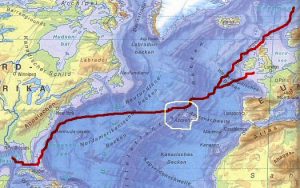 of the Gulf Stream. Up until the beginning of the last ice age, the island was still so narrow that the Gulf Stream could flow around it. Through continuous eruptions of at least nine active volcanoes in the northern part of the island, the Gulf Stream was pushed roughly 20 degrees southwards in around 21,000 B.C.
of the Gulf Stream. Up until the beginning of the last ice age, the island was still so narrow that the Gulf Stream could flow around it. Through continuous eruptions of at least nine active volcanoes in the northern part of the island, the Gulf Stream was pushed roughly 20 degrees southwards in around 21,000 B.C.
In circa 10,400 B.C., after Atlantis collapsed into the suboceanic Atlantic plates in the wake of severe earthquakes and intense volcanic activity, the former gulf stream passage in the north of Europe was clear again! Given this, it was only logical that the European ice sheets would melt faster than the North American ones. Over a period of a thousand years, the world’s oceans rose by an unimaginable 120 meters. They flooded every port city and lower-lying settlement of the Atlanteans and the natives. …
22. Reasons for the Sinking of Atlantis
Mauna Kea, a volcano on the island of Hawaii, rises about 6000 meters above the surrounding ocean floor and subsequently emerges another 4205 meters above sea level. The combined weight of the island and this 10,205-meter mountain—the tallest in the world—has made the Pacific Plate sag by several hundred meters. This has created a deep trench.
Behind this trench, the plate bulges slightly upward to compensate for the weight of the island. The mutually opposing arches give the thin plate the stability required to carry the immense weight of the island, which is constantly increasing in height through persistent lava flows.
Hawaii is also situated over a hot spot, a part of which is in a continual state of flow because of the perpetually active volcano. Because the column of rising magma has a larger diameter than the archipelago itself, the supposition is that the upsurge of hot matter creates a widespread elevation of the ocean floor around Hawaii.
This phenomenon also occurs at other locations on the earth where there are hot spots or plumes. No one can predict how long a suboceanic plate can structurally compensate for the enormous weight of an island. When it can no longer do this, the island collapses into the plate, which is only 5 to 10 kilometers thick. …
… The following geological conditions caused the collapse of Atlantis in around 10,400 B.C.:
- With its enormous weight and nine active volcanoes, the huge island was “rooted”
- on the unstable Mid-Atlantic Ridge,
- with the high water content of the rock serving as a lubricant
- for two thin, divergent suboceanic plate boundaries
- over an active, probably very large hot spot or mantle plume with an excess of extremely hot magma, potentially resulting in abnormal volcanic eruptions.
Which of the factors listed ultimately triggered the collapse of Atlantis, nobody knows. Even tod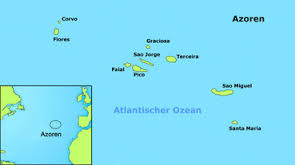 ay, the Azores Islands are still linked by a large, solid undersea shelf whose dimensions match Plato’s description of the enormous mountains on Atlantis.
ay, the Azores Islands are still linked by a large, solid undersea shelf whose dimensions match Plato’s description of the enormous mountains on Atlantis.
The ocean floor, which is divided by the Mid-Atlantic Ridge, descends to a depth of 4500 meters below sea level on the European side; the suboceanic plate on the western side descends to 7500 meters below sea level. The striking difference in elevation of the two plates is evidence that Atlantis sank along with the western seabed by around 3000 meters. …
23. Far-reaching Natural Disasters in the Americas
… In North America, there were fierce volcanic eruptions that were probably linked to the sinking of Atlantis. Thousands of prehistoric animals and plants were discovered in the La Brea Tar Pits in Los Angeles. The bones of mammoths, mastodons, bison, horses, camels, sloths, and saber-toothed tigers as well as human skeletons had been fragmented and flung wildly about.
In the San Pedro Valley, archaeologists found a mastodon skeleton in an upright position and surrounded by volcanic ash and sand. On the edge of Mexico City, while attempting to drill a well, residents stumbled upon a large collection of bones from a herd of mammoths as well as camels, horses, and bison. Experts surmise that the animals were killed by two volcanic eruptions and the resulting ash fall prior to 9000 B.C.
Among the ruins of the city of Tiahuanaco on Lake Titicaca, Professor Posnansky discovered the remnants of human and animal bones, jewelry, shards, and hand tools, all in chaotic disarray, indicating a massive natural disaster that in his opinion took place between 11,000 and 10,000 B.C.!
The widespread deaths of countless people and an estimated 40 million animals presupposes extremely severe volcanic eruptions and prolonged ash fall, along with vast amounts of dust particles that darkened the skies for such a long time that the food chain broke down.
An event of this type occurred roughly 60 million years ago. Following a meteorite collision in the south of Mexico, the sky darkened to such an extent worldwide that the dinosaurs died out for want of food. Only small mammals that could adjust to the new conditions for life on earth survived the massive disaster. Between 11,000 and 9000 B.C., 70 species of large mammals went extinct in the Americas! No one knows whether the unusual events were not in fact the result of the sinking of Atlantis. …
… There is a further argument that favors the extreme age of the native Indian record! The Popol Vuh repeatedly speaks of the “Lords of the Underworld” and their dramas. I found myself wondering at which point in time the Maya lived in subterranean caves. I was now confronted with a puzzle. In the Stone Age, advanced civilizations originated only on the banks of large rivers like the Nile, the Euphrates, the Tigris, or the Ganges. The Mayan people lived in a vast region of Central America and required a great deal of fresh water—but there was no large river!
Since large areas of Mexico go for months on end without rain, researchers wondered how t he Maya could survive. Then, ten years ago, two American divers began to systematically explore numerous water holes. They found that virtually all the cenotes—or “ts’onot,” as the Maya call them—are linked with one another through underground canals, grottoes, and 100 cave systems over a total distance of 550 kilometers! The divers had discovered the largest underground fresh-water system on Earth!
he Maya could survive. Then, ten years ago, two American divers began to systematically explore numerous water holes. They found that virtually all the cenotes—or “ts’onot,” as the Maya call them—are linked with one another through underground canals, grottoes, and 100 cave systems over a total distance of 550 kilometers! The divers had discovered the largest underground fresh-water system on Earth!
Twelve thousand years ago, as the sea level continuously rose, a large number of the later water holes, underground canals, passageways, and caves gradually became flooded. It was here that the Lords of the Underworld mentioned in the Popol Vuh had lived! The American divers also found access points to the sea as well as the skeletons of manatees that had wandered into the cave system.
There is one further proof of my theory about when the disaster described in the Popol Vuh took place! In the underwater cave called “Hoyo Negro,” divers from the Projecto Espeleológico de Tulum found the oldest known human skull on the North American continent among the skeletal remains of an elephantlike mastodon, a species that went extinct before 10,000 B.C.! …
Thoth described the dramatic sinking of the island as follows: “… Thereupon did the great waters descend upon the world [Atlantis], drowning and inundating everything. The equilibrium of the earth changed [the island sank] until only the Temple of Light [that glowed in the morning or evening light] remained, which stood on the large mountain in Undal [one of the ten kingdoms of Atlantis] and still looked out above the water. There remained yet a few survivors who had been saved from the flood ….
“… Then I [Thoth] gathered together the sons of Atlantis and took all my records from the sunken Atlantis into the spaceship. I gathered all my forces and many powerful magical instruments [high-tech devices] … Then we ascended upon the wings of the morning … Below us, the great Temple sank beneath the waves … Thereupon, we quickly fled on the wings of the morning and flew to the land of the children of Khem [Egypt] ….”
A further record points us toward the same event. Le Plongeon deciphered the hieroglyphs of the Cuicuilco Pyramid in Mexico City as follows: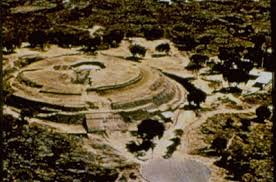
“… A land in the ocean was destroyed and its inhabitants killed in order to turn them to dust …”
Following this natural disaster, both the Egyptian and the native Indian priests recognized the necessity for the careful preservation of various accounts on Atlantis, including those on the sinking of the island, the blueprints for the “sacred sites,” and the mathematical and astronomical knowledge of the “gods.”
The world of the Atlanteans was founded on the division of labor, which meant that they could no longer sustain their accustomed standard of living in the wake of the disaster. If a global catastrophe were to annihilate the majority of humanity today, we would no longer have the capacity to build or utilize cars, airplanes, computers, cell phones, or any other of the conveniences of our civilization. Without working power, water, or gas lines, and without replacement parts or highly specialized suppliers, we would be helpless. …
I informed you about some contents of my new book.
You are looking for an unusual present? Buy my book!
„The Legacy of the Atlanteans“
which is now available in English language – without pictures – as E-Book and Paperback by Amazon, Google & Co, iBooks, Barnes & Noble, Tolino, txtr. and your local book stores (ISBN 9783741864902). I am sure; you want to know all facts about the ancient culture.
Dear friends of my web blog!
Every day I read your comments and I am happy, that all statements are positive, encouraging and that you will return to www.inferno-atlantis.de
If you expect an answer, you must send your mail to:
M1Ullrich@t-online.de
If the spelling in my blog is not correct, you must consider, that my German or English texts are translated automatically by other providers into different languages!
Michael Ullrich

